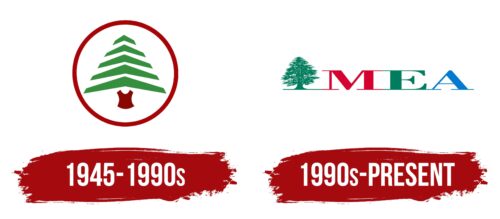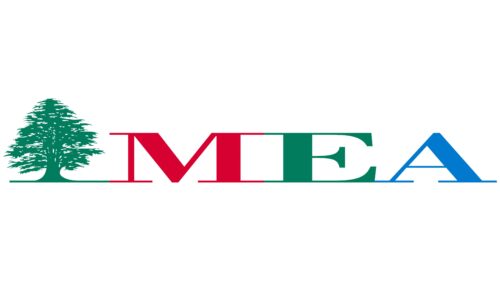The Middle East Airlines logo reflects the airline’s uniqueness, national roots, and heritage. The colorful emblem embodies comfort, reliability, confidence, and a drive for positive change.
Middle East Airlines: Brand overview
In 1945, Middle East Airlines (MEA) was founded on May 31 by Lebanese businessman Saeb Salam with the support of Air France. The airline began with a modest fleet of five De Havilland DH.89A Dragon Rapides. Establishing was pivotal in advancing Lebanon’s aviation industry, positioning the country as a regional transportation hub.
The airline commenced operations on January 1, 1946, connecting Beirut with neighboring cities such as Nicosia, Amman, and Cairo. This inaugural flight began a new era in Lebanese aviation, fostering stronger ties among Middle Eastern nations.
During the 1950s, the company significantly expanded its fleet and route network. The airline acquired more modern aircraft, including the Vickers Viscount and De Havilland Comet, enabling it to launch flights to Europe. 1957, the company introduced its first transatlantic route to New York using leased aircraft.
The 1960s were often called the company’s “golden age.” The airline modernized its fleet with jet aircraft like the Caravelle and Boeing 720. The company became synonymous with luxury and comfort in air travel, attracting passengers worldwide. During this period, the airline expanded its network with new African and Asian destinations.
The onset of the Lebanese Civil War in 1975 posed significant challenges for the company. Despite the turmoil, the airline maintained its operations on a limited scale. The company was crucial in keeping Lebanon connected to the outside world during this difficult time, often operating flights under challenging and dangerous conditions.
Following the end of the civil war, the airline embarked on a recovery and modernization process in the 1990s. The airline updated its fleet with new Airbus A310 and A320 aircraft. The company worked to rebuild its reputation and expand its route network, resuming flights to previously closed destinations.
In 1998, the Lebanese government initiated a restructuring program to improve efficiency and prepare the airline for potential privatization. This involved optimizing the route network, reducing costs, and enhancing service quality.
Fleet modernization began in the early 2000s with the order of new Airbus A321 and A330 aircraft. These additions improved operational efficiency and passenger service quality.
On June 28, 2012, the airline joined the SkyTeam global airline alliance. This membership significantly enhanced the company’s collaborative opportunities with other carriers and improved passenger offerings.
2016, the airline ordered new Airbus A330-900neo and A321neo aircraft, underscoring its commitment to further fleet modernization and efficiency enhancements.
Despite facing global challenges in the aviation industry and Lebanon’s economic crisis in 2020, the company continued its operations, adapting to the evolving market conditions.
Meaning and History
What is Middle East Airlines?
This is Lebanon’s national carrier, based in Beirut. It is known for its resilience and ability to operate in the region’s challenging geopolitical conditions. The company operates a modern fleet, primarily consisting of Airbus aircraft, serving routes to Europe, the Middle East, and Africa. It stands out for its Cedar Miles loyalty program, integrated with the SkyTeam alliance, allowing passengers to earn and redeem miles on partner flights worldwide.
1945 – 1990s
Of course, it is surprising to see a tree in a company’s logo associated with the sky, altitude, and flights, as there seems to be no apparent connection. In this case, the tree symbolizes the country where the airline originated and operates. The emblem features the image of the famous Lebanese cedar – a powerful coniferous tree that adorns Lebanon’s national flag, coat of arms, and currency.
The evergreen tree symbolizes confidence, determination, extensive reach of aviation services, a wide network of routes, and high reliability. The cedar is known for its massive and sturdy trunk, incredible height, and dense canopy. It firmly roots itself in the ground, easily withstanding challenges and remaining in a favorable position. It does not threaten to fall under the force of the wind and instills confidence in all who surround it.
The base element of the logo is a white circle enclosed in a maroon-brown frame. This narrow ring highlights the central element – the massive coniferous tree. The tree’s coniferous nature is indicated by the stepped arrangement of the improvised branches – green stripes resembling large arrows. These branches serve three functions:
- Representing the cedar’s crown with its characteristic tapering towards the top;
- Symbolizing a runway;
- Acting as arrows pointing upwards.
The trunk is colored in a brown-red shade and is slightly set apart from the tree. This structure avoids cluttering the logo’s internal space and maintains ample open space to convey a sense of airiness, freedom, and breathability.
Using a national symbol, the airline focuses on national aspects, authenticity, and cultural heritage, showcasing its resilience in the aviation market. This chosen image perfectly fits the company’s concept and makes the logo cohesive, meaningful, and professional.
1990s – today
Middle East Airlines, based in Lebanon, features a logo with the Lebanese cedar tree. This tree is also on the country’s currency, coat of arms, and flag. The logo shows the tree in dark green, with a detailed trunk and thick foliage, giving it an abstract look. The same green color is used for the letter “E” in “MEA,” while “M” is red, and “A” is blue. The thin, elongated serifs of the letters match the horizontal base of the tree.
The Lebanese cedar in the logo evokes national pride and identity. Though unrealistic, the uniform dark green color contrasts with the colorful letters, making the logo memorable. Different colors for each letter in “MEA” add a dynamic feel to the design, keeping it visually interesting and thematic.
The detailed cedar tree highlights the airline’s connection to Lebanese heritage and culture. The powerful trunk and dense foliage symbolize strength and resilience. Despite the monochromatic green, the tree’s detailed rendering enhances the logo’s impact.
The color variation in “MEA” creates a visually appealing contrast and emphasizes the airline’s diversity and vibrancy. The red “M,” green “E,” and blue “A” work together to form a balanced palette that is both eye-catching and representative of the brand.
The thin, elongated serifs add elegance, complementing the cedar tree. This design choice ensures the text does not overpower the image but works together to create a cohesive and sophisticated emblem.






